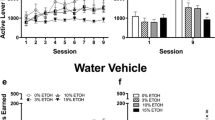Abstract
Voluntary ethanol consumption in Wistar rats was examined in a choice situation between water and ethanol. In each session continuing over 5 days, ethanol at five different concentrations from 2.5 to 45% (v/v) and water were given as reinforcers for FR-30 lever-press responses during 12-h light and 12-h dark periods with food available. The results indicated that rats preferred 2.5–5% ethanol to water, but water to 30 or 45% ethanol. Daily net ethanol consumption per kg body weight increased monotonically as a function of its concentration and reached a mean value of 9.08 g/kg at 45%. Rats drank most of the ethanol and water during the dark period, despite the large amount of ethanol intake occurring at that time.
Similar content being viewed by others
References
Beardsley PM, Lemaire GA, Meisch RH (1978) Ethanol-reinforced behavior of rats with concurrent access to food and water. Psychopharmacology 5:97–11
Cicero TJ (1980) Animal models of alcoholism? In: Eriksson K, Sinclair JD, Kiianmaa K (eds) Animal models in alcohol research. Academic Press, New York, pp 99–117
Falk JL, Samson HH, Winger G (1972) Behavioral maintenance of high concentrations of blood ethanol and physical dependence in the rat. Science 117:811–813
Fitzsimons TJ, Le Magnen J (1969) Eating as a regulatory control of drinking in the rat. J Comp Physiol Psychol 67:273–283
Friedman HJ, Lester D (1977) A critical review of progress towards an animal model of alcoholism. In: Blum K, Bard DL, Hamilton MG (eds) Alcohol and opiates: Neurochemical and behavioral mechanisms, Vol 19. Academic Press, New York, pp 1–19
Iso H (1983) Alcohol withdrawal syndrome in rats during avoidance training. Jpn J Psychopharmacol 3:23–28
Iso H, Sakaki N (1982) Lever press responding as a measure of ethanol preference in rats. Psychopharmacology 76:36–39
Meisch RA, Beardsley P (1975) Ethanol as a reinforcer for rats: Effects of concurrent access to water and alternate position of water and ethanol. Psychopharmacologia 43:19–28
Meisch RA, Thompson T (1973) Ethanol as a reinforcer: Effects of fixed-ratio size and food deprivation. Psychopharmacologia 28:171–183
Miller SS, Goldman ME, Erickson CK, Shorey RL (1980) Induction of physical dependence on and tolerance to ethanol in rats fed a new nutritionally complete and balanced liquid diet. Psychopharmacology 68:55–59
Myers RD, Carey R (1961) Preference factors in experiental alcoholism. Science 134:469–470
Myers RD, Holman RB (1966) A procedure for eliminating position habit in preference-aversion tests for ethanol and other fluids. Psychonom Sci 6:235–236
Myers RD, Veale WL (1972) The determinants of alcohol preference in animals. In: Kissin B, Begleiter NY (eds) The biology of alcoholism Vol 2. Plenum Press, New York, pp 131–168
Richter RD, Campbell KH (1940) Alcohol test thresholds and concentrations of solution preferred by rats. Science 91:507–508
Author information
Authors and Affiliations
Rights and permissions
About this article
Cite this article
Iso, H. Voluntary ethanol consumption in the absence of hunger and thirst drives. Psychopharmacologia 88, 101–104 (1986). https://doi.org/10.1007/BF00310521
Received:
Revised:
Issue Date:
DOI: https://doi.org/10.1007/BF00310521




